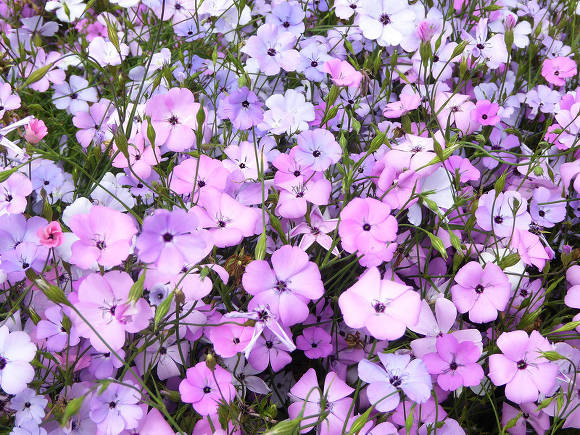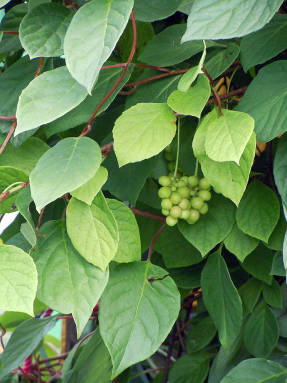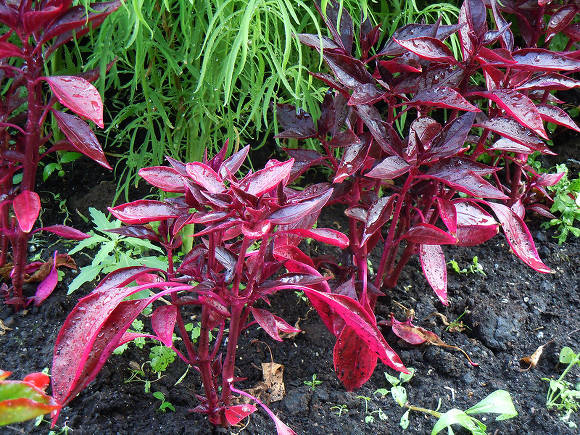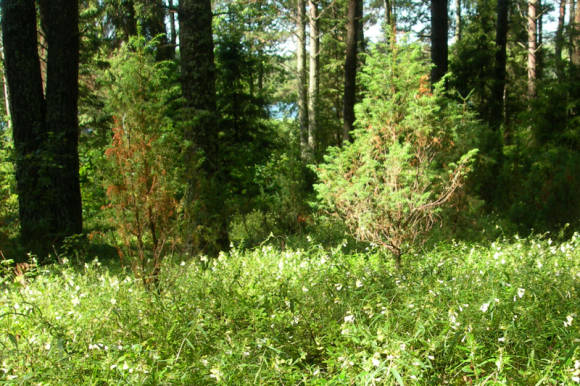Calicant (Calycanthus) is an exotic plant, distinguished by its decorative qualities, unusual flowers and is worthy of the attention of gardeners. The maximum attractiveness of the shrub is associated with large dark red or creamy flowers, similar to water lilies, emitting a persistent pleasant aroma, for which it is called "sweet bush" (Sweet shrub). The bush is densely covered with shiny neat leaves, sitting opposite on short petioles. Calicant is also called calyx, because there are no petals in its flower, instead of them there are petal-shaped colored sepals. Even the Latin name, derived from two Greek words, indicates such a flower arrangement kalix - "cup" and anthos - "flower".
Representatives of the genus Calycanthus belong to the Calicant family (Calycanthaceae), they come from North America and Southeast Asia. Of the four species known in culture, very few are the most resistant to weather conditions in central Russia.
 |  |
Blooming calicant (Calycanthusfloridus) Is a very beautiful, but relatively thermophilic shrub. Naturally grows in the forests of the southeastern United States, from Virginia to Mississippi, where it reaches a height of 3 m. The bush is quite sprawling and branched. All parts of the plant, including flowers, leaves and twigs, smell much stronger than the previous species. Large shiny leaves, 4-6 cm long, oval and elliptical in shape with a pointed apex emit a persistent odor, which is most noticeable when rubbed. Above, the leaves are dark green, and on the underside they are grayish due to the dense tomentose pubescence. At the tops of lateral shoots in June, elegant reddish-brown flowers bloom, up to 5 cm in diameter. The flowers amaze the imagination with their graceful appearance due to the numerous narrow petals, in addition, they exude a strawberry aroma. Fruits (cinarodia) are obovate, up to 7 cm long, hang on the bush for a long time.
In America, Calicanthus blooming, due to its strong aroma, is called the "clove tree" (Allspice), or "Jamaican pepper", and refer to spices. For the indigenous population of America, a decoction of the bark served as a laxative.
Blooming calicant has been cultivated in America since the middle of the 17th century. In the 19th century, the species appeared in Ukraine, Belarus, in the south of the Baltic States. It is grown in Kaliningrad, it is quite common in the parks of the Black Sea coast of the Caucasus. In Central Russia, it is very rare, mainly due to poor winter hardiness. In the botanical garden of St. Petersburg, the species was tested in the 1930s, again in the 1990s, some plants survived. In some years, they can freeze to the level of snow cover, have small annual growth of shoots, rarely bloom, do not bear fruit.
A shrub that can withstand temperatures as low as –25 ° C. In culture, it grows best on fertile, moderately moist soils with good drainage. For him, a sunny area is selected, protected from cold winds.
Ornamental varieties are known:
 |  |
- ‘Ovatus' (Owatus) - with ovoid leaves;
- ‘Atheus’(Eyteus) - a compact shrub with glossy leaves and lush flowering creamy yellowish flowers;
- ‘Margarita’ (Margarita), ‘Edith Wilder’ (Goes Wilder) and ‘Michael Lindsey’ (Michael Lindsey) - with large beautiful red-brown flowers.
Calicantprolific (Calycanthusfertilis) according to the modern foreign classification is recognized as a subspecies of flowering calicant (Calycanthus floridus var. glaucus).
 |  |
It is a relatively resistant subspecies that can grow in temperate climates. Its homeland is in the east of North America, where shrubs up to 3 m in height grow in mountain forests. In the middle lane, it is much lower, 1.2-1.5 m high, and not as densely leafy. Leaves are glossy, ovoid or elliptical, up to 10 cm long, simple, with an even edge. Its leaves on the underside are devoid of pubescence.If the winter is not very harsh, then from the beginning of summer, in June - July, maroon flowers with a diameter of about 4.5 cm, consisting of multiple sepals, appear among the large glossy leaves. The flowers have a faint smell, but the leaves, but especially the bark in a dried state, emit a delicate aroma. Sometimes, during the long warm autumn, a weaker, re-flowering is observed in mid-September. At the end of autumn, green elongated fruits appear on the bush, called "cinarodia", containing nuts inside (they are mistaken for seeds), which do not have time to ripen in our climate.
In culture in America, it has been known since the beginning of the 19th century. It has been growing in Moscow since the 1950s, it does not bloom every year. He loves fertile, moderately moist soils, prefers areas protected from cold winds, with good lighting. When planting, drainage must be provided, stagnation of moisture in the soil can destroy the plant, creating a favorable environment for the development of root rot.
In late autumn, in order to protect the shrub from frost, young seedlings must be carefully bent to the ground and covered with coniferous spruce branches or fallen leaves. To protect them from the cold, the bushes are also tied with kraft paper or modern non-woven covering material. In early spring, as soon as the danger of severe frosts has passed, the mulch and shelter should be removed, but not earlier than mid-April. Practically every year it is necessary to carry out sanitary pruning, removing dry shoots and branches. Since flowers develop on the shoots of the current year, pruning and lightening of the crown is carried out in early spring in March-April. Some gardeners throw the cut twigs of Calicant on the coals to add a special flavor to the kebab.
In the southern regions of Russia, the following decorative forms of the prolific Calicant can be tested:
- ‘Nanus' (Nanus) is a dwarf bush with small ovoid leaves;
- ‘Laevigatus’(Lavigatus) and’Ferax’(Ferax) - leaves below, flowers are dark brown;
- ‘Purpureus' (Purpureus) - with reddish leaves, especially on the underside;
- ‘Glauca’(Glauka) - with grayish-blue leaves on the underside and light brick flowers.
This is an exclusively original shrub, suitable for single and group plantings, in good harmony with various tree and coniferous species.

Western calicant (Calycanthusoccidentalis) native to western North America, including California and southern British Columbia, where it chooses moist habitats near streams and along the banks of ponds, grows on light loamy soil, withstands partial shade. It is a sprawling bush up to 4 m high with a loose crown. It has large glossy leaves, elongated-ovoid, up to 20 cm long, sparsely pubescent. The flowers are single, bisexual, but lighter in color, brick-red or creamy-beige, 5-7 cm in diameter, almost devoid of a pleasant smell, have a weak sour aroma. Moreover, its bark and leaves are quite fragrant. For this, in America, the Western Calicant is called the "Californian carnation tree" (Californiaallspice), sometimes used instead of cinnamon. However, the plant contains the toxic alkaloid calicantin, similar to strychnine, which is dangerous to humans and should be treated with extreme caution. The dried bark has medicinal properties, its decoctions are recommended as an expectorant for colds, sore throats and stomach disorders.
The shrub can withstand winter frosts with temperatures down to -15 ... -20 ° C. It is suitable for areas with mild climates. It is grown on the Black Sea coast of the Caucasus: in Adler and Sukhumi, as well as in the Crimea, where the bush blooms and bears fruit. In the south of Russia, this species significantly freezes over in cold winters, but it can produce shoots. In the botanical garden of St. Petersburg, it was tested in the middle of the 20th century, where it froze every year to the root collar, and after 5 years of cultivation, it completely fell out.
Calicant chinese (Calycanthus chinensis) from the eastern part of China. Chinese botanists in 1963 in the multivolume edition "Flora of China" gave it the name - Sinocalycanthus chinensis. Shrub up to 3 m high, up to 4 m wide, with grayish-brown bark.The leaves are bright green, shiny, obovate, large, up to 15 cm long, very fragrant. In autumn, the leaves turn bright yellow. The flowers are located at the ends of the shoots, also large, up to 6-7 cm in diameter, fragrant. Interestingly, the outer circle of sepals is burgundy, the middle part of the flower is pinkish-white, and the inner circle surrounding 16-19 stamens with yellow anthers is represented by narrower, pale yellow perianth lobes.
The shrub blooms in the 4th year, blooms in May-June. The fruit is bell-shaped or pear-shaped, 3-4.5 cm long. Seeds (more precisely nuts) contain the alkaloid calicantin. The plant is weakly winter-hardy, can withstand temperatures as low as -23 ° C. In central Russia, the species has not been tested, it is probably more promising for greenhouses.
Breeding calicant
Calicant can be propagated by seeds, but in the middle lane it practically does not bear fruit, so it is propagated by cuttings.
For better rooting of green cuttings, their lower part is dusted with "Kornevin" or dipped for 16 hours in a 0.5% solution of heteroauxin. Cuttings are planted in a light fertile substrate. When planting, cuttings are placed obliquely at a distance of 3-5 cm from each other, regularly sprayed with water, preventing drying out. The best rooting results can be achieved in a greenhouse at a temperature of + 16 ... + 20 ° C and little shading.
If you managed to purchase seeds, for example, write them out from the catalog, then they will need scarification. Nuts are covered with a dense skin, through which the root is difficult to break through, so they are pre-soaked for 48 hours in hot water at a temperature of + 60 ° C. Sowing is carried out in a pot with light fertile soil, where, with regular moisture and room temperature, seedlings appear in 3-5 months.
Photo by the author







